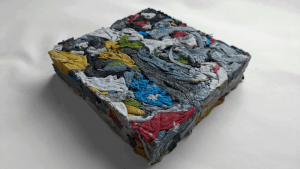From the Series
When asked to describe their sound, Keenan Nathan Oakes, who plays electric guitar for the Sakawa Boys, says, “I think we play a very interesting mix of music. It’s definitely not indie and not shoegaze. It’s somewhere between that.“
Shoegaze is a sub-genre of alternate rock characterised by the significant use of guitar effects and indistinct vocal melodies that blend into the sound of the guitars. It’s called shoegaze because early trailblazers of the genre stood still during performances, giving the impression of gazing at their shoes.
But the Sakawa Boys certainly don’t stand and gaze at their shoes.
In our exclusive video with them during band practice, they display an engaging and contagious spirit (they’ve anectotally been quoted as calling their music “sungaze”).
After releasing their debut track, “Lazy Eys”, the band became a hit on the Cape Town music scene. They performed a number of live shows after that, catapulting them onto the South African music radar.
“John brings a very cool pop element in terms of vocals. Skye’s guitar can be quite noisy but also very pretty and melodic. I think Peter and I are quite primal in our rhythmical approach to things. It makes an interesting mix when it all comes together,” says Keenan.
“We have a very wide taste in music,” adds Skye, who plays electrical guitar. “And we all really like everything form hip hop to classical music to heavy metal.”
The band creates music collaboratively. If it doesn’t work, it doesn’t get used. “I think the nice thing about all of us is that none of us are too precious about something,” lead vocalist and electric guitarist, John, says.
“It’s always difficult to gauge people’s reception across the board. I think that the biggest priority for us as a group has been that we enjoy it and if we are able to enjoy that properly ourselves, then we can convey that to the audience, and they receive that well and they give that back, which is the joy of us playing live.
“We have a raging debate over what a song is and what an idea is” says John. “And what our genre is” Keenan pipes in.
While the band is getting more popular, they still face a number of challenges: audience reception, performance venues and earning a living.
“Our style of music is not really accessible to your standard music fan. Sure they’ll have a good time in the moment but they’re not going to go home and listen to your music,” says Keenan. “We want to appeal to people that really appreciate our music and there’re only a handful of those people here.”
The biggest challenge with being a musician in South Africa for John is sustainability. 'Can I choose to work as a musician or artist and make ends meet and not make Afrikaans music?' he asks.
They’re not taking a jab at Afrikaans music or musicians; it’s more of a genuine query about the music-buying culture in local and global contexts, which is subject to fluctuations depending on taste and accessibility. In the South African context, the Sakawa Boys desire a greater audience that will appreciate their music.
The band is hoping to take the lead set by the likes of Spoek Mathambo, Fantasma and Petit Noir by breaking their local boundaries and extending to an international market. John says: “Locally there seems to be a weird sense of confinement about what you can do, but the global outlook has flattened compared to what it was 20 years ago.”
Innovation means putting constraints on your creativity. It means saying ‘I’m not going to make use of this and I’m not going to work off of that platform. I’m going to say that these are my rules and these are my constrictions and within these restrictions I’m going to come up with something creative that belongs to me, says John.
Catch the Sakawa Boys at the Design Indaba Party at The Side Show on the 26 February 2015.









